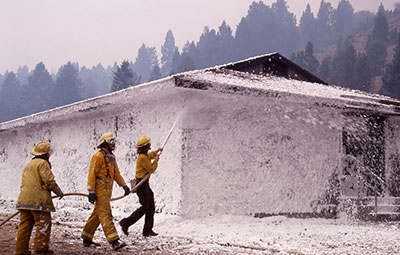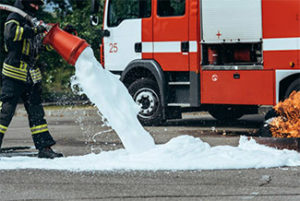AFFF Firefighting Foam Lawsuit
AFFF Chemicals Linked To Cancer
AFFF lawsuits are being filed on behalf of affected firefighters, military members and airport workers nationwide. Have you been exposed to firefighting foam?
You may be eligible to file an AFFF firefighting foam lawsuit against the product manufacturer. Our attorneys will help you seek compensation for your medical expenses and other damages resulting from your exposure to AFFF.
Firefighting foams contain synthetic chemicals referred to as PFAS that pose serious health risks, including numerous types of cancer. If you or a loved one has been exposed to an AFFF product, even only for training purposes, you may be able to seek compensation. Keefe Law Firm is at the forefront of AFFF firefighting foam lawsuits, and is currently representing current and former firefighters throughout the United States that have been exposed to firefighting foam in their careers.
AFFF and Why it is Used
AFFF, which stands for aqueous film-forming foam, is a synthetic, water-based surfactant. AFFF firefighting foam was designed for the suppression of Class B fires—fires in flammable liquids such as gasoline or petroleum. The foam is effective in smothering fires and preventing them from taking in oxygen necessary to continue burning. Because of its effectiveness in fighting petroleum and jet fuel fires, AFFF was commonly used by the military (including extensively by the navy on aircraft carriers), public and private airports and civilian fire departments for both training exercises and fire suppression. Many fire departments have been exposed to AFFF through Fire Drill Trainings and have discontinued their use of firefighting foam, but many military bases in the United States continue to use it. The Federal Aviation Administration (FAA) reportedly required firefighters to use AFFF firefighting foam at airports until 2018.

AFFF firefighting foam has been sold for decades by major chemical manufacturers like 3M, Tyco, DuPont and Chemguard. Also for decades, it is alleged these companies incorporated toxic chemicals in their AFFF manufacturing. AFFF contained PFOA (perfluorooctanoic acid) and PFOS (perfluorooctanesulfonic acid), both belonging to a family of chemicals known as PFAS (per- and polyfluoroalkyl substances). In 2010, the EPA requested chemical manufacturers stop using certain types of PFAS in firefighting foam.
PFAS in AFFF – What Makes Them Dangerous?
PFAS (per- and polyfluoroalkyl substances) are a group of man-made chemicals that have been used in the manufacturing of a wide variety of products since the 1940s. PFOA and PFOS chemicals found in AFFF are referred to as C-8 chemicals, referencing their extremely strong 8-carbon atom chain. Commonly referred to as “forever chemicals,” PFOA and PFOS break down at an exceptionally low rate in nature and in the body.
Once in our bodies, these toxins have half-lives of up to eight years. As they accumulate over time, the potential for adverse health effects grows exponentially. PFAS have been designated by the International Agency for Research on Cancer (IARC) as a possible human carcinogen, meaning exposure may cause cancer in humans. This determination was made based on epidemiological evidence linking exposure to diseases like kidney and testicular cancers and other health complications like hormone disruption, harm to the immune system, and liver and kidney toxicity.
Studies Find Possible AFFF Cancer Relationship

In 2020, the International Journal of Environmental Research and Public Health published a study that found PFOA to exhibit up to five key carcinogenic characteristics. Specific cancers and illnesses linked to PFAS exposure have been identified, including but not limited to:
- testicular cancer
- kidney cancer
- thyroid disease
- ulcerative colitis
- preeclampsia
- pancreatic cancer
- bladder cancer
- prostate cancer
AFFF Environmental Hazards
Once released into the environment, the chemicals in AFFF firefighting foam may contaminate soil, surface water, and groundwater. The chemicals may also enter drain systems which can carry the chemicals to remote locations. Much of this exposure has been identified at military sites. Because of this, the Environmental Working Group (EWG) has developed a map designating the sites of both suspected and confirmed contamination, and providing relevant information for those who may have been exposed.
PFAS chemicals can enter and accumulate in the human body through water consumption or other forms of exposure, putting those who are exposed at risk of developing serious health problems including cancer.
In 2018, a federal inquiry determined that PFAS chemicals are more dangerous than initially reported. This determination led to the revision of recommendations for safe levels of AFFF exposure.
Firefighting Foam Exposure Risks & Occupations Using AFFF

The following occupations are considered to have the highest risk of AFFF exposure because they often involve working directly with firefighting foam:
- Firefighters
- Military members
- Airport workers
- Chemical plant workers
Who Else May Be at Risk of AFFF Exposure?
AFFF poses risks beyond that of occupational exposure. Once released into the environment through the usage of foam, the toxins in PFAS contaminate soil, and both surface and groundwater. This provides another route for which AFFF can impact entire communities; those living in or around military sites, or sites in which AFFF has been disposed of, may be ingesting PFAS through drinking water due to contaminated municipal water supplies.
AFFF Lawsuits – What is Being Done?
Current AFFF lawsuits allege that the AFFF manufacturers were aware of the potential health risks from AFFF exposure, but continued to produce their products and market it as safe for use. For this, the attorneys at Keefe Law Firm are determined to hold them accountable.
3M, the Minnesota Mining and Manufacturing Company, is claimed to be responsible for the toxic exposure of firefighters and other workers that have employed the use of AFFF. They, along with others like Chemguard, Tyco Fire Products, National Foam and Buckeye Fire Equipment, are being sued for continuing to manufacture AFFF after being made aware of the danger exposure to their product posed. Claims from all over the country are currently being consolidated into a multi-district litigation in South Carolina Federal Court.
Filing An AFFF Firefighting Foam Lawsuit
Keefe Law Firm is currently representing firefighters, military members, and civilians who are suffering from cancer or other related illnesses due to exposure to AFFF firefighting foam. If you or a family member were diagnosed with testicular cancer, kidney cancer, thyroid disease, pancreatic cancer, ulcerative colitis, bladder cancer, breast cancer, or potentially other illnesses, you may qualify to file a claim. If you do qualify, you may be eligible to be compensated for personal injuries, pain and suffering and. economic damages arising from your cancer diagnosis, such as medical expenses, lost wages, and reduced earning capacity.
Get A Free and Confidential Case Evaluation
For generations, the attorneys at Keefe Law Firm have fought for the rights of victims of workplace injuries, and held negligent companies accountable for their harmful products. If you or someone you know were exposed to AFFF and have developed cancer, please contact us regarding possible legal representation. To speak with an attorney about your legal options, please call: 888-416-0685.
AFFF Lawsuit Update
January 2024:
- Judge Gergel granted a motion extending the deadline by which the parties must meet to discuss ongoing disputes and other newly filed motions.
- In December 2023, more than 300 new cases were filed. As of this month, the total number of pending cases in the AFFF MDL has reached 6,715.
December 2023:
- Issued early this month, Case Management Order 26B outlines the process by which certain plaintiffs will be designated the Personal Injury Bellwether Discovery Pool.
- The court will pick a selection of personal injury plaintiffs from lists provided by both plaintiff and defense counsel to be included in the discovery pool in order to assess the value and legitimacy of these cases.
- Currently, the court has compiled a pool of 25 plaintiffs alleging the following injuries: kidney cancer, testicular cancer, hypothyroidism, thyroid disease, and ulcerative colitis.
- To examine the remaining cases in the MDL, those not included in the initial Bellwether Discovery Pool, Judge Gergel has requested a catalog of plaintiffs alleging injury beyond the scope of the Bellwether Discovery Pool. The court will hold a “science day” to hear from experts regarding the epidemiology of those claims.
November 2023:
- Over the past month, more than 350 new AFFF cases have been filed in the multidistrict litigation (MDL), bringing the total number of claimants over 6,400.
- As determined by Case Management Order 26A, November 14 is the deadline for parties to submit their proposed group of claimants to be chosen as bellwether candidates. The purpose of trying these selected cases first is to help assess the value of all future cases.
- Three “Suggestion of Death” notices have been filed regarding plaintiffs that have passed away awaiting resolution of their claims.
- The court continues to devote its attention to cases involving water providers who’s supplies have been contaminated with AFFF. The MDL’s personal injury claims regarding individuals impacted by AFFF exposure are expected to be addressed in the coming months.
October 2023:
- As of this month, the total number of claimants filed in the AFFF multidistrict litigation (MDL) has exceeded 6,000 cases, as attorneys nationwide continue to file on behalf of individuals and water providers who have been exposed to AFFF.
- The majority of newly filed cases are related to water contamination and have begun to be resolved through settlement deals reached this summer.
- The Village of Farmingdale, located in New York, has been appointed to serve as a bellwether plaintiff in order to initiate legal action against the remaining defendants who have yet to reach settlement agreements with municipalities who’s water systems have been contaminated.
- The Environmental Protection Agency has announced it will fund new research to investigate how PFAS affects plants and animals in agricultural environments in an effort to identify and mitigate exposure.
September 2023:
- The Court continues its focus on the recent settlements for water systems contaminated with PFAS.
- Another type of firefighting foam (AFFF), Telomer-based AFFF, does not contain PFOS, but may contain trace amounts of PFOA. Because of this, claims involving Telomer-based AFFF were not include in the global water provider settlement. This month, MDL Judge Richard Gergel issued an order scheduling Bellwether trials to address these cases for August 2024.
- Claims against major defendants DuPont, 3m, and Chemours remain paused awaiting approval of settlement.
- Judge Gergel announces upcoming Bellwether trials involving water utility systems from four states: California, South Dakota, New York, and New Jersey.
August 2023:
- Since June, over 1,000 new AFFF cases have been filed, bringing the total to over 5,600 claimants.
- A new study published by the National Cancer Institute indicates a connection between testicular cancer and exposure to per- and polyfluoroalkyl substances (PFAS). Researchers investigated associations between PFAS concentrations and testicular germ cell tumors (TGCT) among U.S. Air Force servicemen, and found that elevated PFAS concentrations were positively associated with TGTC.
July 2023:
- Total number of cases in the AFFF MDL tops 5,000
- With water contamination cases nearing settlement, attentions will turn towards AFFF claims regarding individual firefighters and military service members. Our attorneys continue to work diligently on behalf of our firefighter and military clients, and are still accepting new cases.
June 2023:
- In a motion filed jointly by the Plaintiff Leadership Committee on June 2, the parties request a delay in trial due to being close to reaching a resolution.
- Based upon reported progress in settlement negotiations, US District Judge Richard Gergel grants a 3-week postponement of the first bellwether trial.
- 3m, the Chemours Company, and DuPont de Nemours announce that they have reached a tentative settlement of certain water provider claims.
- Speculation of a settlement announcement for personal injury claims continues, meaning time may be of the essence to file a claim.
May 2023:
- The first bellwether trial, City of Stuart v. 3M Co., et al., scheduled to start on June 5, 2023.
- MDL Judge Richard Gergel denies defense motion for summary judgment, allowing for the majority of claims in the first bellwether trial to be decided by jury.
- Court orders hearings to address objections regarding trial exhibits and evidentiary disputes.
- Defense submitted final list of trial exhibits, briefs, and intended depositions.
April 2023:
- Total number of cases pending in the MDL nears 4,200.
- The U.S. Centers for Disease Control and Prevention (CDC) announces the “National Firefighter Registry” (NFR) for Cancer intended to monitor and analyze the already heightened rates of cancer amongst firefighters. The project seeks to gather data on firefighting and compare it with information from state cancer registries. The initiative is being managed by the National Institute for Occupational Safety and Health (NIOSH) and all firefighters in the United States are urged to enroll.
March 2023:
- Total number of cases pending in the MDL surpasses 4,000.
- The International Association of Fire Fighters (IAFF) files suit in Massachusetts state court accusing the National Fire Protection Association (NFPA) of imposing testing standards for firefighting protective gear which required the use of PFAS in manufacturing the materials. The IAFF alleges the NFPA necessitated the use of PFAS in the middle moisture barrier layer of firefighters’ bunker gear, and that the NFPA could have altered their standards to allow other materials to be used in place of the contaminated gear.
February 2023:
- Total number of cases pending in the MDL reaches roughly 3,700.
- Judge Richard Gergel set to rule on motions questioning the admissibility of expert testimony and scientific evidence in water contamination bellwether trial City of Stuart v. 3M Co., et al.
January 2023:
- The first bellwether trial in the AFFF class action MDL will be in the case of the City of Stuart v. 3M Co., et al.
- In City of Stuart v. 3M Co., et al, the defense argued a lack of evidence linking their specific AFFF products to the contaminated city water. Plaintiffs filed opposition response briefs to defendants’ motion for summary judgment, citing expert testimony and evidence which proved that the named products were a substantial source of contamination to the water supply in question.
December 2022:
- Total number of cases pending in the MDL reaches roughly 3,400.
November 2022:
- Presiding Judge Richard Gergel of the United States District Court of South Carolina appoints retired Judge Layn Phillips as a mediator for settlement conferences intended to take place before the first bellwether trial.
October 2022:
- The first bellwether trial is set for June 2023 and will involve municipal water contamination.
AFFF Lawsuit FAQs
Who is eligible to file an AFFF firefighting foam lawsuit?
If you’ve been exposed to firefighting foam and have developed cancer or certain other serious illnesses, you may be eligible to file an AFFF firefighting foam lawsuit. Those who have been exposed most heavily are military personnel, namely those who served in both the Navy and Air Force, both career and volunteer civilian firefighters, and others who used AFFF occupationally.
What is the status of AFFF litigation?
Most AFFF litigation is in the federal courts. The federal litigation for AFFF is centralized in the District for South Carolina. Currently, the parties are conducting discovery, which includes exchanging documents and taking depositions.
What are AFFF lawsuit settlement amounts?
Settlements in litigation depend on a variety of factors. Their amounts may differ based on the injury sustained, time and nature of exposure, or other-case specific details.
How do I file an AFFF lawsuit?
To file an AFFF lawsuit, consult with an attorney at our firm on the details of your exposure and serious illness. Attorneys who are already in the process of filing AFFF lawsuits and who are experienced in the area of mass tort claims will walk with you step-by-step through this process to ensure you are fairly compensated.
What injuries are related to an AFFF exposure?
Those who are currently filing AFFF-related injury claims are suffering from a wide variety of illnesses, the most common being kidney cancer, testicular cancer, pancreatic cancer, bladder cancer, leukemia, lymphoma, neuroendocrine tumors and prostate cancer. However, claims are not limited to these illnesses. Consult with an attorney to assess your potential claim.
Do I need a lawyer?
Any individual is able to represent himself/herself without an attorney; however, it is strongly recommended that you consult with or retain counsel to file an AFFF lawsuit. An attorney will better know your rights and will be able to fight for fair compensation, as well as provide support throughout the process, including any paperwork and legal communications.
Why should I choose Keefe Law Firm to represent me?
Our law firm possesses skilled attorneys that have represented firefighters and their families for years, and we are prepared to offer the highest standard of representation no matter where you reside in the country. With decades of experience and success in past mass tort litigation, attorneys at Keefe Law Firm will work tirelessly to achieve the best possible outcome.
